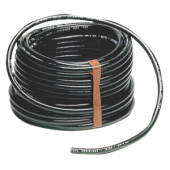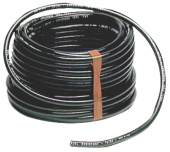An outboard fuel hose is a flexible tube designed to transport fuel from the fuel tank to the outboard motor. Made from durable, marine-grade materials, it ensures safe fuel delivery even in harsh marine environments, resisting UV rays, weather, and ethanol-blended fuels.
|
1-2 weeks delivery time Price incl. 19% VAT The Osculati 52.732.10 PVC Fuel Pipe, available in a convenient 25-meter roll, is specifically engineered for use with unleaded petrol. Its construction includes coextruded anti-petrol PVC, reinforced with a nylon braid and a black PVC layer, ensuring durability and resistance to fuel-related elements. With a diameter of 8x13 mm and an operating pressure of 3 bar, this fuel pipe offers reliability and safety for various marine or automotive fuel applications.
|
€ 42,66
-
+
| |||
|
1-2 weeks delivery time Price incl. 19% VAT Osculati 52.732.11 - Rubber Fuel Pipe Black 25m Roll comes in two variants to suit different fuel transport needs. The PVC variant, crafted using multilayer extrusion technology, features a fuel-resistant PVC layer, a polyamide reinforcing insert, and an external black PVC layer, making it suitable for high-octane gasoline. The rubber variant is constructed from black rubber reinforced with strong synthetic threads, ensuring durability and reliability in fuel transportation. With a working pressure of 10 bar and dimensions of 8x15 mm, this 25m roll is a versatile solution for various applications.
|
€ 92,58
-
+
| |||
How does a B1-15 fuel hose differ from an A1-15 fuel hose in terms of marine applications?
A B1-15 fuel hose and an A1-15 fuel hose serve different roles in marine applications due to their construction and usage guidelines. The B1-15 fuel hose is generally used for outboard motor fuel lines and is designed for low permeation, making it suitable for above-deck fuel systems where emissions are a concern. In contrast, the A1-15 fuel hose, with a barrier lining, is ideal for inboard engine fuel systems and provides extra protection against permeation, making it compatible with gasoline and diesel applications while resisting weather, UV, and ethanol degradation, meeting SAE J1527 and USCG standards.
What materials are commonly used in marine fuel hoses to ensure resistance to weather, UV, and ethanol exposure?
Marine fuel hoses are commonly made from reinforced rubber or specialized synthetic materials that provide durability and flexibility for marine environments. These materials are chosen for their resistance to weather, UV exposure, and ethanol-blended fuels, which are often used in boats. Additionally, barrier layers are sometimes added to reduce fuel permeation and maintain compliance with marine fuel line standards.
What role does a primer bulb play in a fuel line assembly for outboard engines?
A primer bulb in a fuel line assembly for outboard engines creates the initial pressure needed to draw fuel from the boat's fuel tank through the fuel line hose to the engine. This helps ensure that the engine starts smoothly by pushing fuel through the boat fuel line, especially after long periods of inactivity. The primer bulb, combined with secure fuel connectors and fittings, is essential in maintaining a steady flow of marine-grade fuel to the outboard engine, preparing it for reliable operation.
How does the design of a boat fuel tank help minimize fuel permeation?
The design of a boat fuel tank minimizes fuel permeation by incorporating low-permeation materials and barrier-lined construction, which reduce the escape of fuel vapors. Many tanks utilize a blend of marine-grade materials that resist weather, UV, and corrosion, ensuring durability in harsh marine environments. Additionally, fittings such as steel hose clamps and marine hoses, like type B1-15 or A1-15 fuel hoses, help secure the fuel system and further prevent vapor loss, maintaining fuel integrity and meeting EPA standards.


